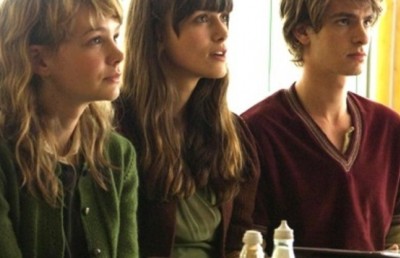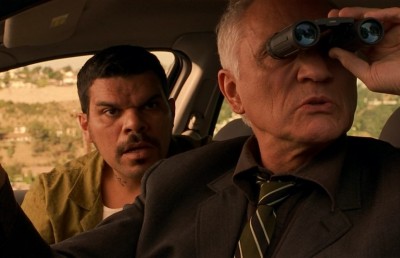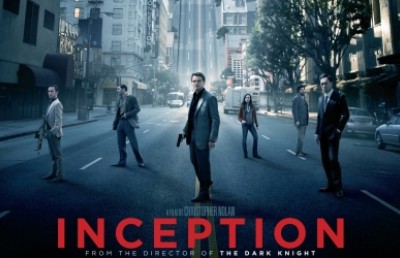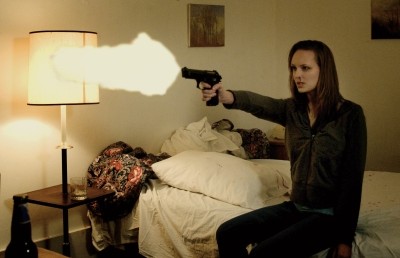Segments of Madness in Emmanuel Carrère’s La Moustache
When the Surrounding Normalcy Speaks Lies and Madness
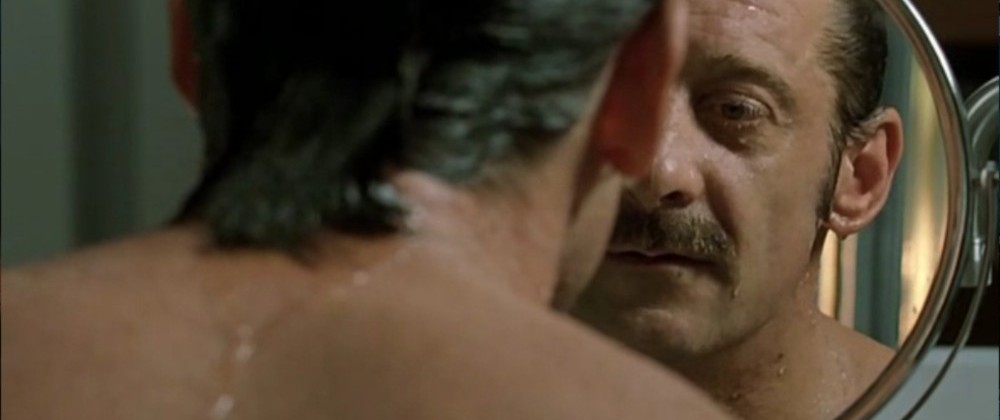
“Being mad […] can mean acting as if one were sane.” (Phillip Going Sane 3-4)
Editor’s Note: Some of the quotes in this article have consciously been left in their original French.
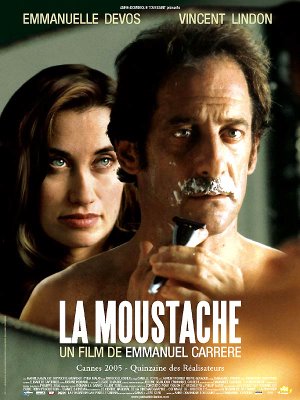
British psychoanalyst Adam Phillips has observed that, “Psychoanalysis asks us to reconsider the unacceptable, in ourselves and in others . . . And at the same time it asks us to wonder why we should want to do this . . ” (Side Effects xiv-xv). La Moustache (2006), a film by French director Emmanuel Carrère (1957-) [1] deals precisely with this element of the unacceptable and the element of surprise, both of which correspond with moments that present the possibility of trauma. In the film, the traumas result from some necessary characteristic that defines the protagonist or the work in question. Another psychoanalyst, Jacques Lacan, has written about our attitude in regard to the unexpected and always-present lack (le manque), which is the presence—not the absence—by which trauma reveals itself as a constant part of experience that must be accepted as such by human beings in order for them to avoid future surprises or traumatic events. Julia Kristeva indicates that the first traumatic experience that remains as a permanent presence initially correlates to a repulsion toward certain elements immediately related to language such as food, waste, feces, etc. (10), but she holds that abjection actually derives its power by excluding the subject in favor of an object whose existence it rejects, whose presence is an infinite object of pleasure or desire: “De cette élément, signe de leur désir ‘je’ n’en veux pas, ‘je’ ne veux rien savoir, ‘je’ ne l’assimile pas, ‘je’ l’expulse […] ‘je m’expulse, je me crache, je m’abjecte” (10-11). Even as the discovery of an abject object forces the subject out of his or her comfort zone, abjection issues form a desire of self-rejection (for both the object itself and the desiring subject), not because of its abjectivity but rather because it perturbs, invading an order or established system, therefore upsetting or destabilizing a certain identity:
Ce n’est donc pas l’absence de propreté ou de santé qui rend abject, mais ce qui perturbe une identité, un système, un ordre. (Kristeva, Pouvoirs de l’horreur 12)
It is not the absence of cleanliness or health that renders the abject, but that which disturbs an identity, a system, an order. (editor’s translation.)
This explains why Marc, the protagonist of La Moustache, searches through the trash (a symbol of his own home) for evidence of the mustache he had shaved off earlier that morning, an act that none of his close friends or family members seems to have noticed. This is an initial instance of the motif of malaise that emerges in this work by Carrère, a filmmaker who is not content to simply question, in his socratic ways; he suggests that to question is the only possible answer, since formal answers can never be considered full truths. This system of questioning, which experiences a momentary fall or disappearance, is connected to the identity of the je itself. Contrary to what one might expect, Marc does not derive pleasure in finding himself, but rather from being in close proximity to the abject, which causes him to constantly seek some sort of adjustment, if such a thing were possible, to the fragility of his own dislocated sense of identity, a process that will be analyzed [2] in this article. If viewers consider Marc a character who experiences a trauma, they can treat him as if he were undergoing analysis, which makes him the analyzed subject and makes viewers, the spectators, his analysts. Although other sets of eyes involved in this intrigue would like to occupy this privilieged position of examining, or, better yet, of listening — as in psychoanalysis — to the other, here it is the protagonist’s place to be heard, even as he believes he is the listener. But the other(s) are not capable of seeing or hearing Marc because they hold on to a “custom-made truth,” the truth of the bourgeoise social order which they inhabit. It becomes clear that the existence or non-existence of a mustache would lead to the realization of the status Marc unconsciously seeks in order to live a proper life, comme il faut, in accordance with the norms of his social class,. In fact, it seems that Marc does not really want to be different, but rather to assimilate to the norm. Unable to do so, his identity dissolves in a search that involves internal and external journeys to other destinations, including French Polynesia.
The trash through which Marc searches in La moustache assumes a metaphorical nature. In addition to delving into it physically, he embarks on extended journeys in order to confirm his own sanity and thus prove the insanity of the other(s), a maneuver that produces the same result as digging in the garbage: If the protagonist is in fact sane and everyone else is crazy, then he is much like a person with obsessive-compulsive disorder (linked to an unresolved, recurrent fear of some unknown desire) as Adam Philipps puts it ; “As in neurosis, we are pursuing something by running away from it. (The neurotic is always arriving at the place he is running away from).” (Terrors and Other Experts 48). And according to the Vocabulaire de la psychanalyse, an obsession as much as a compulsion;
Cliniquement, type de conduites que le sujet est poussé à accomplir par une contrainte interne. Une pensée (une obsession), une action, une opération défensive, voire une séquence complexe de comportements sont qualifiés de compulsionnels lorsqeu leu non-accomplissement est ressenti comme devant entraîner une montée d’angoisse. (Laplanche et Pontalis 84)
Clinically, a type of escape which the subject is pushed toward by an internal constraint. A thought (an obsession), an action, a defense mechanism, seen as a sequence of complex behaviours qualified as compulsions, in which a failure to overcome them is felt as a surge of anxiety. (editor’s translation)
The character thus continues to inhabit the fringes of society, surrounded by an inpenetrable and, above all, indivisible lack or excess of common sense that only he perceives. Despite all of this, Marc begins a search for the abject that guides him to a web of infinite paths, none of which lead him to any answers. However, it should be noted that upon initiating the metaphorical journey depicted in this film, Mark derives immense pleasure despite the traumatic pain caused by his investigation; he discovers that his wife lies pathologically, that his father may be dead and that he has no memory. The photos he finds prove that he actually had a mustache disappear. Meanwhile, not a single friends stands by Marc throughout the process; on the contrary, everyone doubts his account and shuns him. A sensation of solitude is common when one emerges from analysis. In fact, Freud addresses the role of solitude in his development of the notion of estrangement from self or others:
Quant à la solitude, au silence et à l’obscurité, nous ne pouvons rien en dire, sinon que ce sont là effectivement les facteurs déterminants auxquels s’attache chez la plupart des humains une angoisse enfantine qui ne s’éteint jamais tout à fait” (L’inquiétante étrangeté 139).
As for solitude, silence, and obscurity, we can not say, except that they are effectively determining factors onto which are attached, for every human, eternal childhood fears. (editor’s translation).
Consequently, being marginalized does not equal the absence of desire or pleasure (jouissance). From the moment in the film’s opening scene when Marc shaves off his mustache in the bathtub, the viewer sees the hint of an anxious smile, a sign of the repressed pleasure associated with doing something that could be surprising but may go unnoticed (he already knows this without anticipating it). Through the act of shaving off his mustache, Marc effectively cuts away part of his identity and voluntarily alienates himself—both at that moment and in the next scene when his wife rejects the “new” Marc, insisting that he has not changed at all, in effect deleting him from her memory.
Although this article deals directly with the film interpretation of La Moustache, it should be noted that the film is based on the Carrère’s novel of the same name. The film’s first scene depicts a couple that apparently lives well, sharing an immaculate and impeccably appointed home decorated in neutral black, white and gray. This minimalistic scene contrasts with the sanity-insanity dialect soon to ensue, since everything about the environment these characters inhabit, from the colors of the home to their clothing and even the foods they eat—sushi, an equally minimalistic gastronomic choice, appears in two meals—seems flawless. Marc’s unexpected decision to shave off his mustache during the middle of a very usual evening could signify his desire to evade his untouchable surroundings, an escape into abjection, a mistake, a secret, something that would dismantle every perfect object surrounding him: his perfect wife, harmonious marriage, and tranquil family life free of children or any apparent need of excess. Everything is established, so the interesting factor is the change to which Marc will submit himself. One other notable detail regarding the home of Marc and Agnès is that the only other color that is not neutral is a faded green tone, prominent in an abstract painting of the sea that hangs in the dining room, suggesting the fundamental element of water, which becomes increasingly important as the film unfolds. Despite these details, Marc appears to be an ordinary character who has completely adapted to his universe, as Bardet and Caron point out in their analysis of the film:
Un personnage médiocre, dans un univers banal, confronté à un événement étrange, devient peu à peu conscient de sa solitude, de sa différence ou d’une marginalité qui l’exclut du monde, le fait basculer hors de son cadre habituel, dans un autre univers, de l’autre côté du miroir ou du côté de la folie, et finit par lui faire perdre son identité, voire la vie. (Bardet and Caron 23)
An ordinary man in a banal universe is confronted by a strange event. As a result he slowly becomes aware of his solitude, the difference or marginality that excludes him from the world, that shocks him out of his ordinary routine, into another universe, on the other side of the mirror, the other side of sanity, and ends up losing his identity, his life. [translation by editor]
In La Moustache, an unremarkable event triggers the changes in Marc’s banal existence. The moment of surprise occurs when Marc’s wife, who has seen him just minutes before he takes his bath and shaves off the mustache, does not notice the change. His close friends, who have dined with the couple that same evening, are even more oblivious. The protagonist is then overcome by a flood of confusing thoughts that lead him to insist on and persist in understanding the absence of his mustache, as well as the effect that it has or has not had on his friends, his wife, and himself. [3] Indeed, flooding is another metaphor that recurrs at certain, decisive moments in Marc’s course from forgetting to sanity to insanity. In La moustache, the notion of sanity is presented as both recurring problem and desired solution. Marc assumes a transgressive nature when he rejects the label of “mentally ill” that his wife wishes to impose on him by encouraging him to visit a psychiatrist and by looking for ways to confirm his insanity.
As Phillipps observes, “Madness is often associated with the breaking of taboos, whether as cause or consequence (either you have to be mad to break a taboo, or madness is akin to the punishment of breaking one)” (Going Sane 114). By declining his wife’s request that he seek treatment, a suggestion that he initially voiced himself, Marc begins the journey of questioning his own sanity, losing his identity, and searching for signs that validate him as sane, insane, or neither, but signs that at least validate his search for the missing mustache. Given the above details, it is relevant to this reading of La moustache to underscore certain insights borrowed from the discourse of psychoanalysis, including the Freudian motif of estrangement and the double or multiple identities that Marc gradually discovers within himself. In their remarks on Carrère’s novel—easily applied to his film—Bardet and Caron point out the relevance of Freudian concepts:
Les romans de Carrère, en effet, […] dans La Moustache […] sont placés sous le signe de ce que le père de la psychanalyse appelle l’un de ses ouvrages ‘l’inquiétante étrangeté’ [4] définie comme une variété particulière de l’effrayant qui ‘remonte au depuis longtemps connu, depuis longtemps familier.’
Carrère’s novels, indeed, […] in The Moustache […] are under the sign of what the father of psychoanalysis called in one of his works ‘the strangely familiar,’ the ‘uncanny,’ defined as a particular variety of ‘fright’ that ‘is a return to the long time, known, the long time familiar. (editor’s translation)
The situation into which Marc inserts himself is also marked by a certain strangeness emanating from his everyday circumstances, circumstances that provide the outline from which Marc will rewrite his personal story, which had fallen to pieces in the earliest scenes. Marc’s primary objective is to reclaim his life, but the question posed by the film is whether that lost life he yearns for will be revealed as something completely strange, the product of a hallucination. For it is not entirely misleading to think that if a small part of one’s physical identity can cause a character to question basic facts about his life, then everything related to it must be made, observed and critiqued anew in order to re-establish a foundation for a new life.
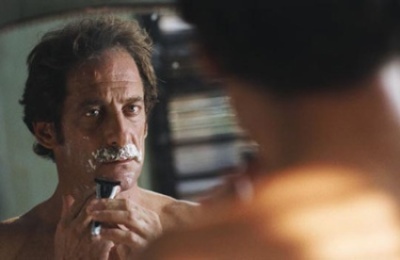
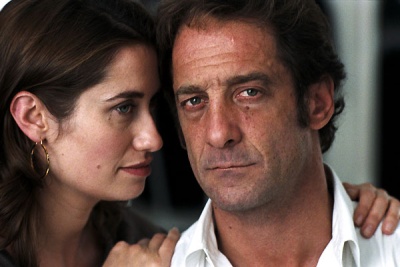
The importance of references to water and the word flood have been mentioned above, and there are at least four moments in which their presence and related implications are imposing. The film opens with a depiction of deep, dark waters flooding the screen, as if the viewer were observing a nocturnal oceanscape. That flooded image suggests the viewer is about to leave the trival and delve into something profound. The second moment in which water appears is also at the beginning of the film, when we see Marc in the bathtub preparing to accompany his wife to dinner at the home of Serge and [wife’s name], a couple whose daughter is Agnès’ goddaughter.
At dinner, Serge accuses Agnès of exercising bad faith and of being a pathological liar, based on an anecdote that occured during a weekend stay at a friend’s home years before. Serge claims that not even on her deathbed will Agnès admit she was to blame for having caused a heater to malfunction, despite having being warned about it by their hosts. The importance of the story is the way it characterizes Marc’s wife, who until now has seemed above reproach. The event and the accusation of bad faith contribute to Marc’s growing distrust of Agnès, a distrust that is clearly manifest when he runs away from home to avoid being forced into an ambulance that would carry him to a psychiatric hospital.
Viewers encounter water imagery for the third time when, as Marc flees home because his wife has summarily decided to commit him so he can “rest” and regain his strengh, he has to run through an intense downpour. Marc refuses to accept the situation and insists on investigating the event, more precisely by getting into a taxi to search for his parents home, which he will not find at the location with which he is familiar. The fourth moment in which water imagery plays a key role is during Marc’s trip to Hong Kong and to Bali, a continued flight from involuntary psychiatric internment. Thus viewers see again the deep, oceanic images from the beginning of the film, this time through Marc’s eyes as he travels on a ferry bound for French Polynesia (at least, that is what the film implies), observed and reflected in the surrounding waters.
The ferry scene is followed by a cut, after which Marc and his wife emerge as if on vacation somewhere far from Paris, apparently in Bali, the same locale Marc sought out during his crisis. Here Agnès again challenges the reliability of Marc’s memory and questions his sanity, and in turn he embarks on a phase full of doubts, questions, and investigations, such as the futile search for his parent’s home mentioned above — another supposed blank in his memory — and his wife’s mention that his father had died a year earlier, another event Marc cannot recall. None of these strange events are reconciled during the film. Nevertheless, Marc persists in his search for signs that would prove the existence of his mustache, such as ID photographs, as well as photos of the couple on vacation in Polynesia in 2003, just a few years ealier, in which the spectator clearly sees a mustachioed Marc. The most disconcerting aspect of this period, which seems to constitute a total blank in Marc’s life, is not just that Agnès does not notice the change in her husband’s appearance, but that she insists that she has never seen him with a mustache. Significantly, at the end of the film she reiterates that claim in a way that almost inverts it, saying that she would like to see him with a mustache, since she has never seen him with one. According to Bardet and Caron, “La Moustache peut être lue comme la description minucieuse d’un cas clinique, le récit d’une décompensation brutale qui révèle une paranoïa pathologique.” (37). (« The Moustache can be read as a minute description of a clinical case, the story of a brutal decompensation that reveals a pathological paranoia. » (editor’s translation) Regarding Agnès’ initial reaction, Bardet and Caron have noted:
Que quelqu’un se rase la moustache sans que ses proches ne s’en aperçoivent, je sais maintenant […]que c’est très courant ; en revanche il y a un tour de vis supplémentaire à partir du moment où le personnage demande à sa femme: “ Tu n’as pas remarqué que je me suis rasé la moustache” et qu’elle lui répond en le regardant : Mais tu n’as jamais eu de moustache ! Là on en arrive à un point qui est de l’ordre de l’invraisemblable complet.” (Interview 116)
Agnès immediately accepts the possibility that Marc might be experiencing a brutal case of paranoia and decompensation because she would prefer to resolve the anguish of the moment they are living pragmatically, via traditional medicine; she wants science to take care of the anxiety, as if it were capable of deleting it. However, the events seem to have a paralyzing effect on Marc, who foregoes all activities except the investigating the existence of his mustache. But the existence or non-existence Marc’s psychological decompensation has less to do with his mustache than with his search for his own identity. The mustache itself had somehow kept the character “compensated” as a human being living a trivial existence, and the denial of the mustache by others causes his identity crisis. Kristeva’s discussion of disgust toward the abject provides a possible explanation for this type of behavior:
Il y a dans l’abjection, une de ces violentes et obscures révoltes de l’être contre ce qui le menace et qui lui paraît venir d’un dehors ou d’un dedans exhorbitant, jeté à côté du possible, du tolérable, du pensable. C’est là, tout prêt mais inassimilable. Ça sollicite, ça inquiète, fascine le désir qui pourtant ne se laisse pas séduire. Apeuré, il se retourne. Écoeuré, il rejette. Un absolu le protège de opprobre, il est fier, il en tient. (9)
In a gesture reflecting the film’s fragmented narrative, let us return to the beginning, when the spectator experiences the same surprise as Marc upon confirming that none of his colleagues notice the absence of his mustache. Again, the real question is whether this represents a case of knowledge or lack of knowledge in the sense that Phillips evokes the term, “From a psychoanalytical point of view, there can be no private knowledge, only knowledge that has been hidden (as esoteric psychoanalysis is a contradiction in terms) ” (Terror and Other Experts xiii). Imagine that the mustache symbolizes the remainder of what was once a symptom. By retaining the mustache-symptom, Marc is able to continue living his persecution fantasy, as if it were a hallucination that is somehow more comfortable than the banal life he actually expererienced.
An analysis of the examples cited following the format of the film, which is fragmented in its treatment of both time and space, reveals the absense of what is practically considered a body part by the protagonist and which functions as a metaphor for his double, a double that welcomes persecution and is always open to answers pertaining to his (in)sanity. As Freud notes, there is another possible motive behind the appearance of the double:
Le fait qu’il existe une telle instance, capable de traiter le reste du moi à l’instar d’un objet, que l’homme a la faculté de s’observer lui-même, rend possible de doter l’ancienne représentation du double d’un nouveau contenu et de lui attribuer bien des choses . . . (81).
The fact that an agency of this kind [the super-ego] exists, which is able to treat the rest of the ego like an object—the fact, that is, that man is capable of self-observation—renders it possible to invest the old idea of a ‘double’ with a new meaning and to ascribe many things to it…. (Freud, The Uncanny, 234).
One such instance in which Marc attempts to observe himself is linked to time. It seems he does not grasp neither the logic of time nor the space that surrounds him. He is immersed in a so-called uchwchronie,
L’uchwronie est au temps ce que l’utopie est à l’espace ; il s’agit donc d’une histoire imaginée, réécrite en quelque sorte, et qu’on substitue à l’histoire réelle”(Bardet and Caron 124).
Uchwchronie is to time what utopia is to space; it is an imaginary story, in a sense recreated, and used as a substitute for the real story. (editor’s translation)
In this case, Marc apparently suffers an actual nervous breakdown, an explanation that favors Agnès’ desire that he return to a state of normalcy.
As the film progresses, Marc’s mustache metonymically assumes the place of language, of his moods and perception, while the spectator sees him becoming increasingly frustrated with the lack of attention and curiosity of those around him, as well as with the absensce of his own words, his inability to express his perplexity and thus verify his own claims.
In La Moustache, Marc nevers tires of trying to explain to his friends and family what is going on, of making them aware of an inexplicable event in his life, the fact that an important aspect of his personality has been erased. The mustache represents his being, his body; it constitutes proof that life flows, and as such its absence should be worthy of at least some sort of comment from his wife: “ . . . visual drive is not the drive to see, but, in contrast to the desire to see, the drive to make oneself seen, etc. . .. Our most fundamental striving is not to observe, but to be part of a staged scene, to expose oneself to a gaze” (Žižek 177-78). Marc constantly exposes himself to the gaze of the other(s) – his friends, his wife, the taxi driver who cannot be sure which way to go, the people on the ferry, the inhabitants of Bali, etc. Thus he ultimately imposes his desire to be observed, but in a torturous way, because he does not realize the exposure to which he is subjected nor the desire that drives him to expose himself to the answer he seeks for that which he lacks. And the farther Marc travels into his fragmented space, the more he is observed, and the less he understands his own fabrication concerning his state of insanity-sanity. This makes sense if we accept Phillips’ contention that “[M]adness resists definition . . . Madness . . . tends to be theatrical” (Going Sane 3-4).
In conclusion, what is really at issue is determining who is acting insane in the analyzed scenes from the film – is it Mark or his wife and friends? Perhaps these characters have decided to play a sinister trick on the protagonist, submerging him in a whirlpool from which there is no escape. The quest for sanity never ends. Regarding the film’s ambiguity concerning who is, in fact, crazy, Bardet and Caron have observed the following:
On ne peut donc qu’hésiter entre deux interprétations, deux lectures mises en concurrence : soit il est fou, soit les autres le sont. De toute façon, l’explication psychiatrique, dans la mesure où elle est assumée par le personnage lui-même, n’échappe donc pas à la folie, si folie il y a ; elle ne peut donc offrir d’échappatoire au lecteur . . . On ne sait cependant si le second degré permanent pratiqué par le personnage allège un peu le sentiment de tragique ou au contraire le rend plus pesant, plus grinçant. (43)
We can not but hesitate between two interpretations, two concurrent readings : either he is crazy, or the others are. In any case, the psychiatric explanation, to the extent that it is assumed by the character himself, does not escape madness, if there is madness. Nor can it escape the reader….We can not say if the second degree practised by the character lightens the sense of tragedy, or on the contrary makes it heavier, more grating. (editor’s translation)
Carrère thus sets up an interminable debate between reason and madness, which fixes the contours of an analysis in which, as explained earlier, Marc acts as the subject, the patient of the director or the viewer. But there is no fact or solution that can explain what occurs in Marc’s life. What seems right about his life will not last, since, despite being a married professional who has several friends and whose parents have supposedly died, he will not be able to maintain a voice that is distant from that of a banal existence. This banality becomes problematic, bothering not only Marc but also the spectators witnessing his life. The solution to the puzzle of Marc’s fragmentation may lie in the concept of trauma as understood by Phillipps, who explains the phenomenon of trauma as something that always happens by chance and brings with it a surprise, “From a psychoanalytical point of view, . . . perhaps more often than we can afford to notice, the things that change us are surprising. They are often side effects, things that happen inadvertently (what is traumatic about the official trauma is often eccentric)” (Side Effects xiii). This is consistent with the film. The trauma related to all of the events that follow Marc’s transformation; his act of shaving off the mustache is actually a product of the gaze of others rather than a result of his own actions.
The sense of persecution and fear revealed during Marc’s search for intelligible answers suggests there is no equilibrium to be found nor answers regarding the existence or non-existence of his mustache. The missing mustache remains both a metonym that slides into embodying Marc’s desire and a metaphor for the discovery of a lack that was always present, but that had never been recognized.
Endnotes
1 “Emmanuel Carrère est un auteur à succès, non pas parce qu’il est l’invité des médias ou défraie la chronique, par son comportement ou ses prises de position, mais parce que ses œuvres, en dépit de sa discrétion, touchent un large public et que la critique, d’accord avec ses lecteurs, le reconnaît comme un écrivain origial et profond.” (Bardet Interview with Emmanuel CARRÈRE 3)
2 The terms analyzing and analyzed come from the field of psychoanalysis and are applicable once an relationship of analysis, in which the subject has become the analyzed, has been established. My approach here is to compare the film itself to the analyzed subject. Thus, the film is treated in this article as the analyzed, with whom we established a relationship of transferrence in order to discuss its various aspects and details.
3 I am indebted to Professor Julie Johnson (Missouri State University) who made informal comments on the film, which enlightned my article as well as the reader’s comprehension, “We as the audience perceive everything with him, and we understand things as he understands them, that he shaves his moustache just as the film begins. His wife and friends and fellow workers perceive it all differently, that he shaved his moustache years ago. The photograph of Bali he thinks will confirm his perception, but his wife doesn’t seem to notice it. Then other breaks occur—his parents (father alive or dead?), etc. As if there were a rip in HIS perception (and ours) of the sequence of time.
He runs away—much water imagery, rain and the river. He rides the ferries in Asia somewhere. And he writes that postcard that becomes an anchor for him to his real time sequence. On the ferry, the scene with the giggling schoolgirls—they see that he’s sitting on the bench backwards, he realizes what they see and smiles, then he moves to the other side of the bench, snapping its back into correct position. THERE he shares a perception of the world with other people. And that shared, communal perception is reinforced when he keeps on riding the ferry and snapping the seatback into correct position for other people. They don’t share language, but they do understand the world. The ferry, for some reason, also evokes Charon ferrying the dead to Hades. He goes to Bali, where time passes and he grows his beard. His wife shows up by surprise, behaving as if it were years ago (on the vacation of the photo)—and he shaves his beard—and moustache (just as she had said he did—in Bali 15 years ago). So, is time repeating itself? His postcard seems to confirm HIS perception of time. And his open eyes at the end suggest that he knows it’s strange.”
4 “Le mot allemand unheimlich est manifestement l’antonyme de heimlich, heimisch (du pays), (…) et l’on est tenté de conclure qu’une chose est effrayante justement pour la raison qu’elle n’est pas connue ou familière. Mais il est évident que n’est pas effrayant tout ce qui est nouveau et non familier ; la relation n’est pas réversible. On peut seulement dire que ce qui a un caractère de nouveauté peut facilement devenir effrayant et étrangement inquiétant (…)” (Freud 33).
“The German word ‘unheimlich’ is obviously the opposite of ‘heimlich’ [‘homely’], ‘heimisch’ [‘native’]—the opposite of what is familiar; and we are tempted to conclude that what is ‘uncanny’ is frightening precisely because it is not known and familiar. Naturally not everything that is new and unfamiliar is frightening, however; the relation is not capable of inversion. We can only say that what is novel can easily become frightening and uncanny” (Freud, 219-220).
Works Cited
Bardet, Guillaume, and Dominique Caron. Etude sur Emmanuel Carrère. La Moustache. Paris: Ellipses, 2007.
Freud, Sigmund. L’inquiétante étrangeté et autres textes. Das Unheimlich und andere Texte. Trans. Fernand Cambon. Rev. J.-B. Pontalis. Paris: Gallimard, 2001.
Freud, S. (1919). The ‘Uncanny’. The Standard Edition of the Complete Psychological Works of Sigmund Freud, Volume XVII (1917-1919): An Infantile Neurosis and Other Works, 1919, 217-256.
Indiana, Gary. “Disaster of Disguise: Emmanuel Carrère’s Counterfeiters.” NY: Bookforum: The Book Review for Art and Culture. April-May 2005, 10-14.
Kristeva, Julia. Pouvoirs de l’horreur. Essai sur l’abjection. Paris: Seuil, 1980.
Phillips, Adam. Going Sane. New York: Harper Collins, 2005.
—-. Side Effects. New York: Harper Collins, 2006.
—-. Terror and Other Experts. Cambridge: Harvard UP, 1995.
Žižek, Slavoj. Looking Awry. An Introduction to Jacques Lacan through Popular Culture. Cambridge: MIT P, 1992.
—-. “Neighbors and Other Mosters: A Plea for Ethical Violence”. The Neighbor: Three Inquiries in Political Theology. Chicago: The U of Chicago P, 2005, 134-90.


